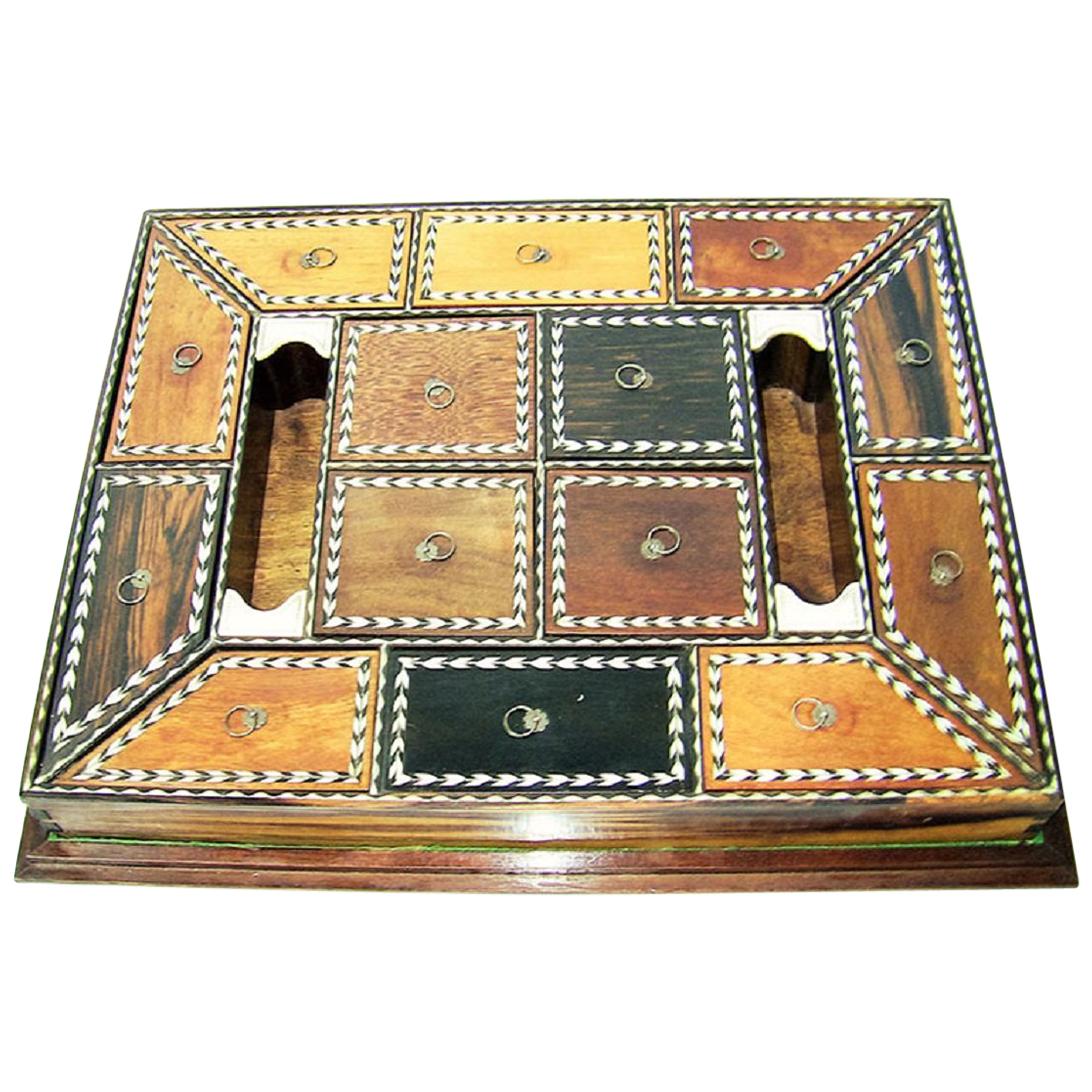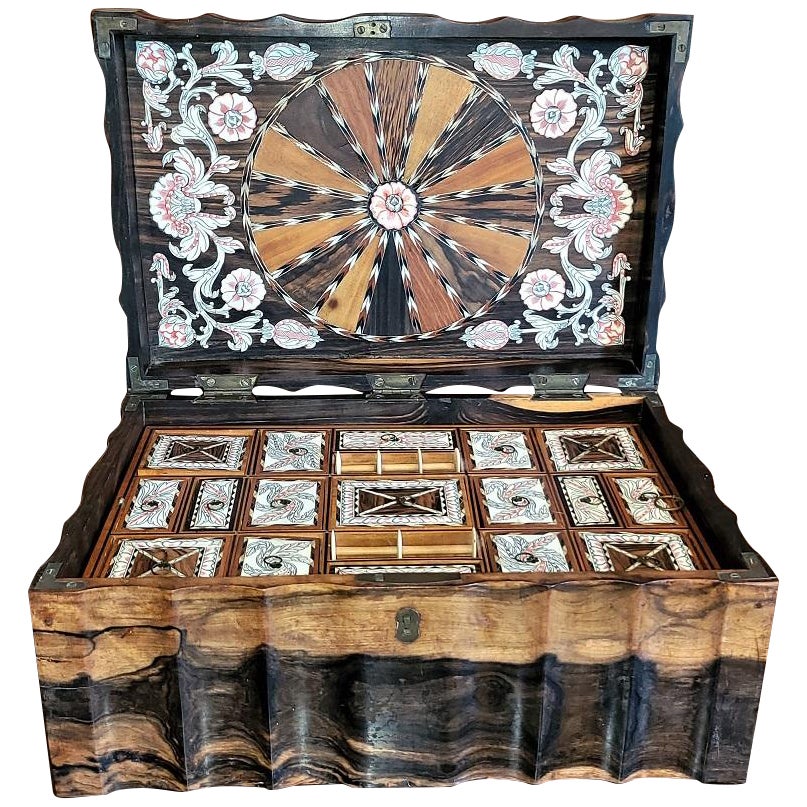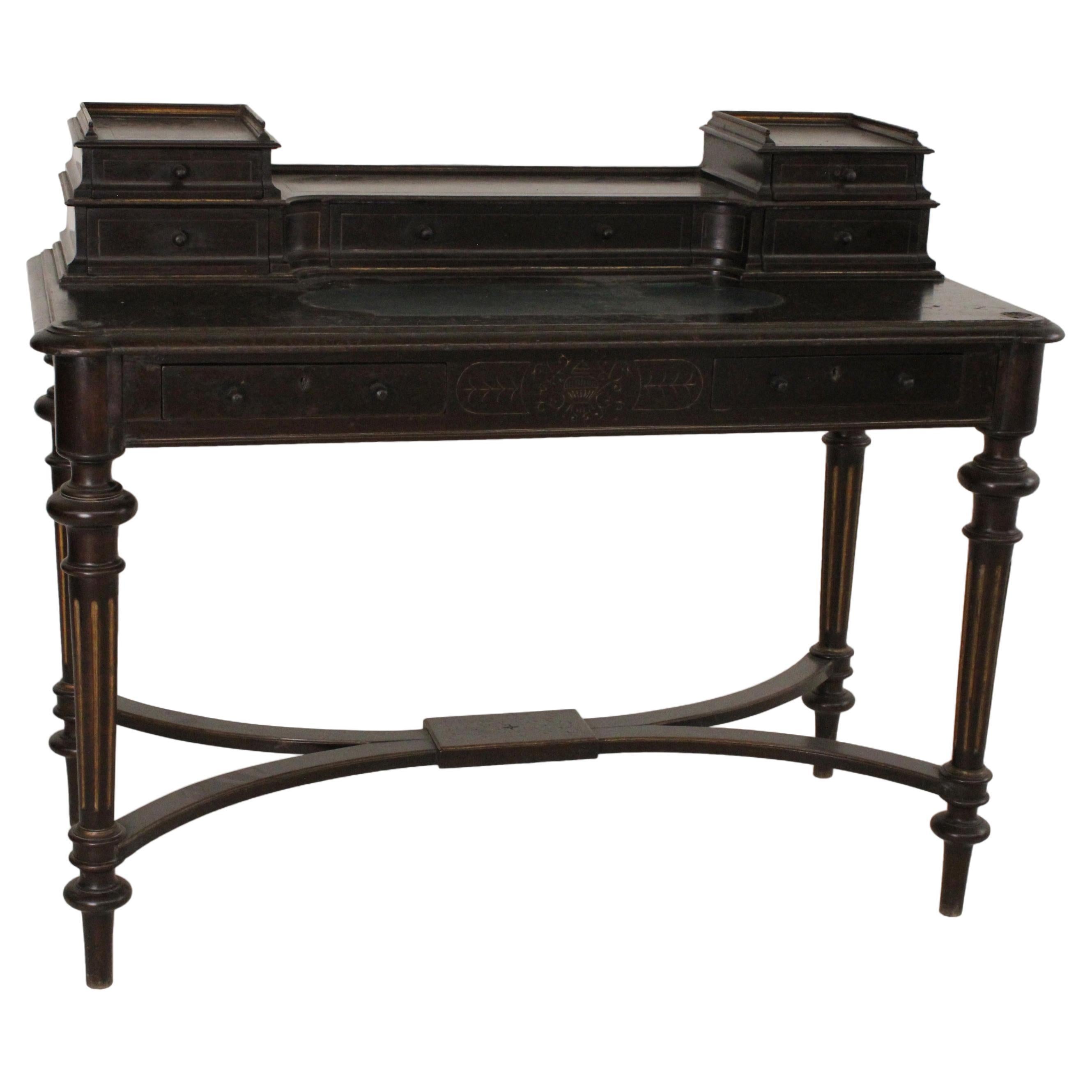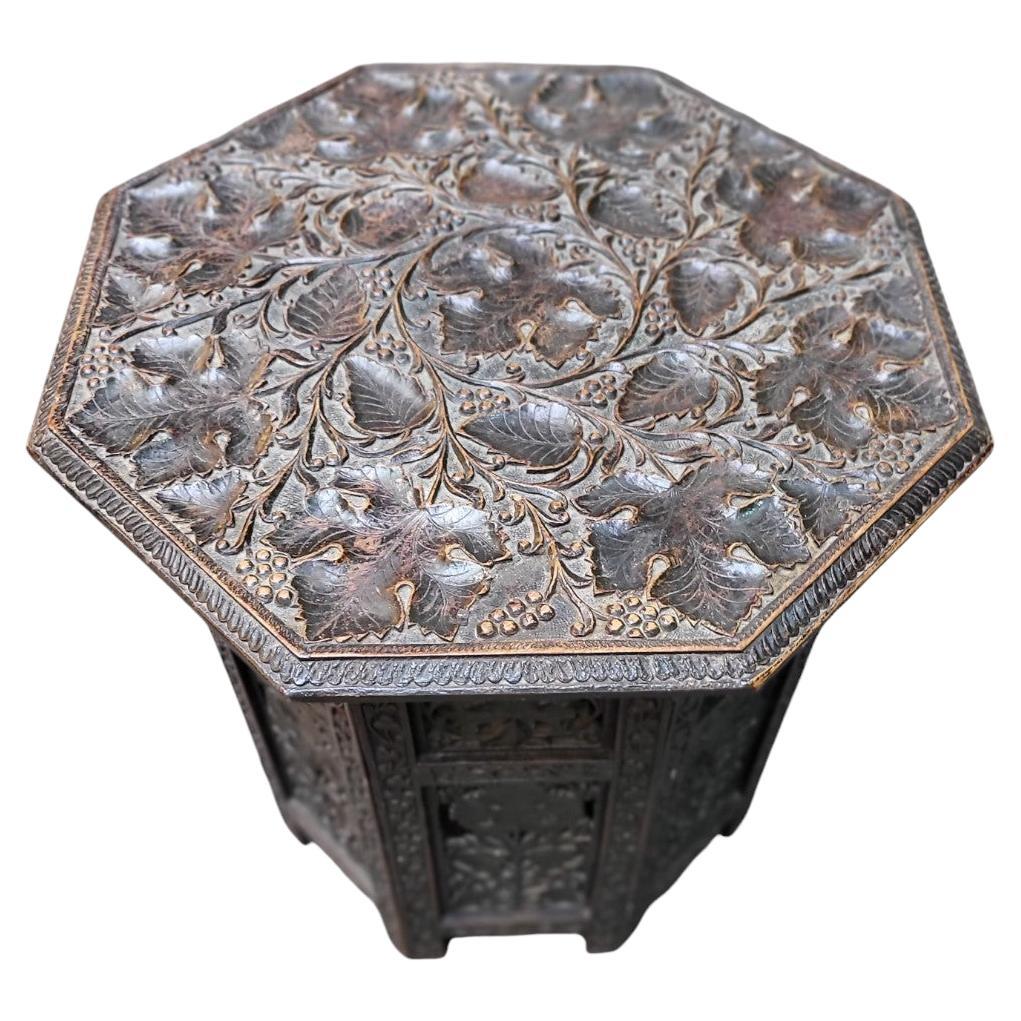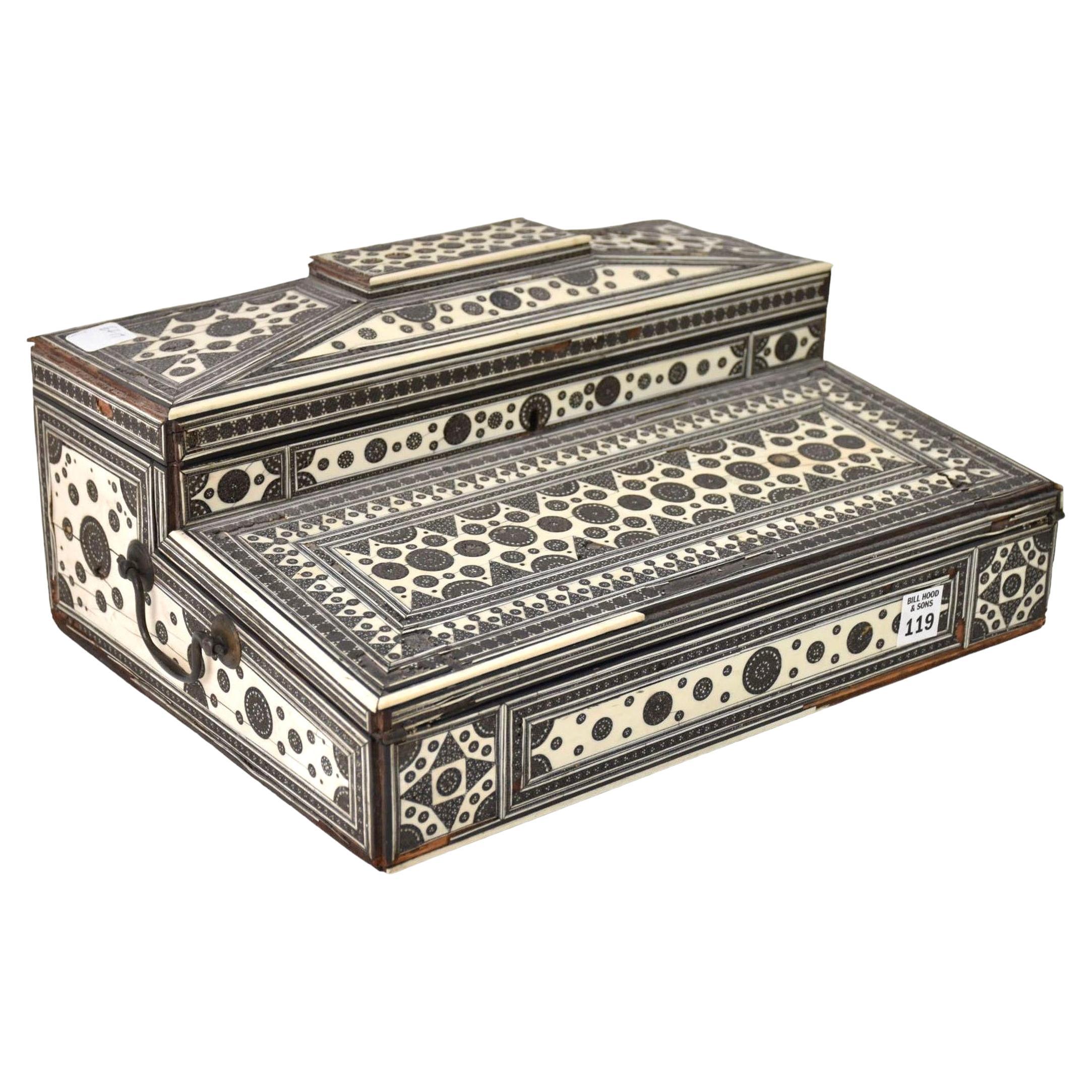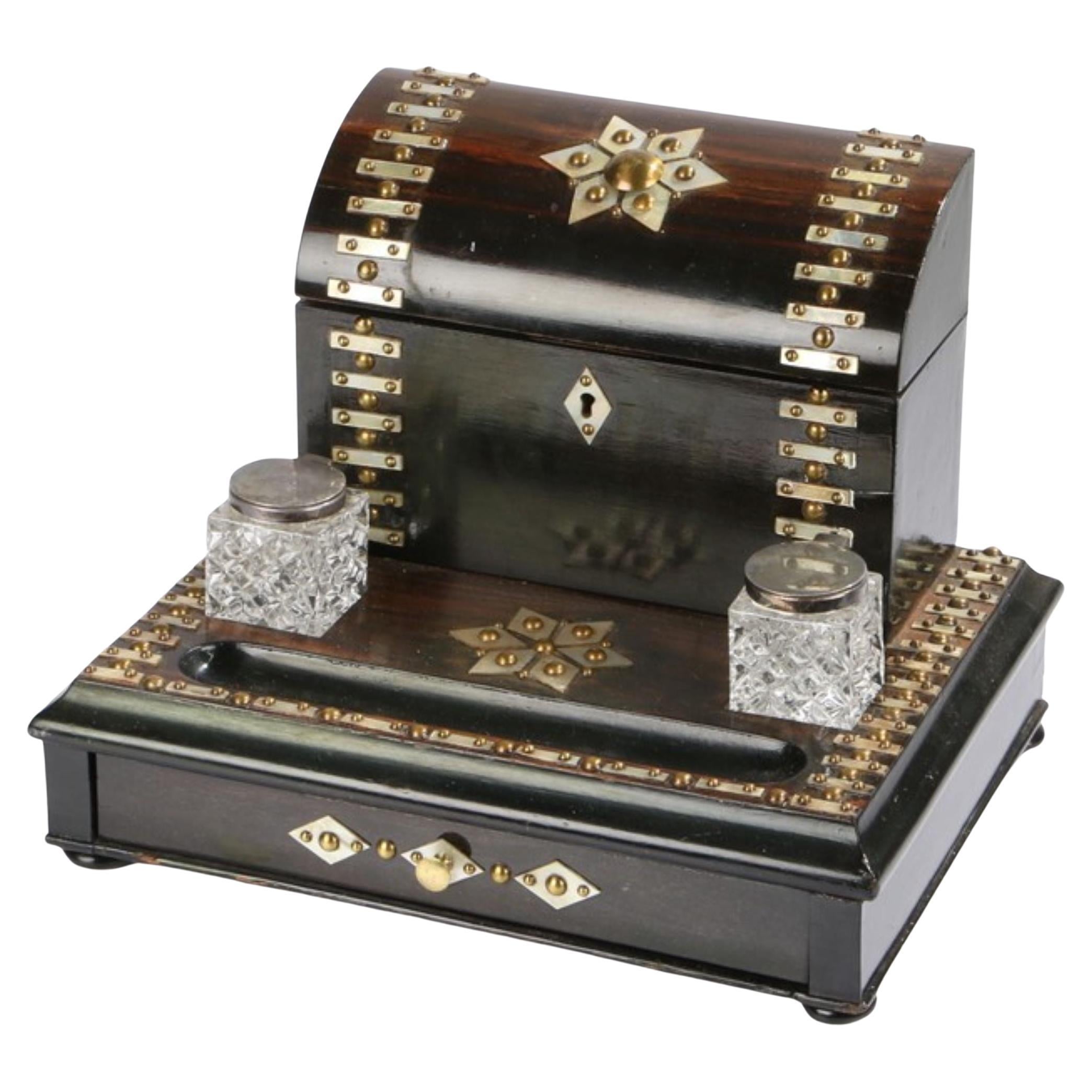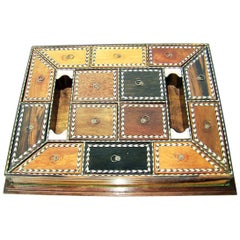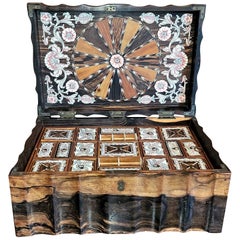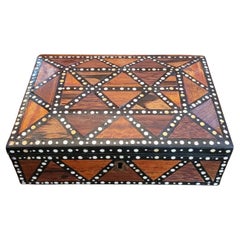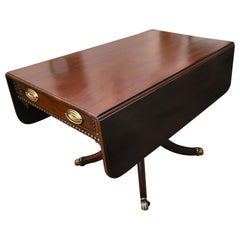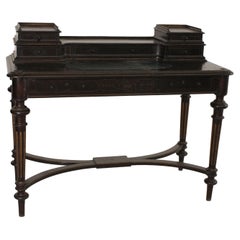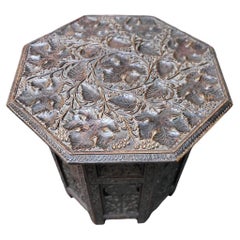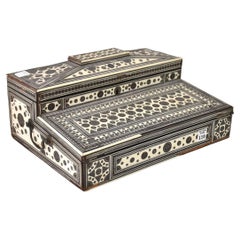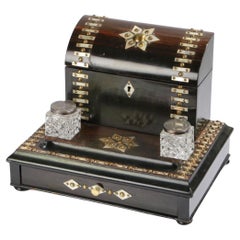Items Similar to 19C Anglo Ceylonese Lap Desk of Museum Quality
Want more images or videos?
Request additional images or videos from the seller
1 of 21
19C Anglo Ceylonese Lap Desk of Museum Quality
$7,999
£6,227.76
€7,082.75
CA$11,508.65
A$12,641.74
CHF 6,606.65
MX$150,763.26
NOK 83,658.10
SEK 77,934.58
DKK 52,925.67
About the Item
Presenting an absolutely fantastic 19C Anglo Ceylonese lap desk of museum quality.
We can safely say that this is one of the finest lap desks we have ever seen !
The Lap desk box is rectangular in shape when fully closed, with the most gorgeous reeding design of the wood all over. This ‘reeding’ in itself makes this box a VERY VERY RARE example.
The ‘box’ was appraised by the prestigious Rothchilds Antiques of NOLA in 1978 and given a value of $1,000 in 1978. Allowing for inflation alone this equates to over $4,200 in today’s value. As experts in Anglo-Indian and Anglo-Ceylonese items we are going to slightly disagree with Rothchilds on one issue: – We do not believe that this box is made from Jacaranda Wood. We believe it to be ebony and coromandel woods. The secondary wood is sandalwood.
Not only is they style and construction of the outer box very unusual and rare but the interior once opened is OUTSTANDING !
The box opens to reveal a writing slope with blue leather insert. Both the top section of the writing slope and the larger bottom section have a lift up lid to reveal a storage area underneath. The larger area is also lined with matching blue leather.
Above the writing slope is a sectioned area for holding writing accessories like inkwells, pens etc. The pend holding lid which is heavily decorated and inlaid with bone, lifts to reveal more space underneath. In the front section is have a highly decorated and inlaid with bone, tubular baton and a simple ebony tubular pointer. We have never seen this before !
The top section is a sliding section, that slides upwards on a pair of brass plates on each side, when fully open to reveal a STUNNING bureau area with 3 doors, 2 drawers and to 2 cubbies. Each is heavily decorated with bone, pewter or silver, inlaid specimen exotic hardwoods and hand painted chevron and floral decorations. The hardwood inlays in triangular sections replicate the look of tortoiseshell.
This section slides downwards to close the box.
This box would have been made in Ceylon (now Sri Lanka) during British occupation and control and would have been made specifically for the British market. It is a form of ‘campaign’ piece and would have been made for a very high ranking British Army Officer. It would have been a VERY EXPENSIVE PIECE WHEN MADE !!!
IT IS A MUSEUM QUALITY PIECE !
In super original condition, with only very minor blemishes through age and use. No key.
Dimensions: Closed the Box is 16.9 inches Wide, 10 inches Deep and 5.25 inches High
Fully Open the box is 8 inches High, 16.9 inches Wide and 16.5 inches Deep
ANGLO-INDIAN AND CEYLONESE BOXES: Anglo Indian boxes were made in India for the English residents from the early part of the 18th century. They were brought back or sent back to England usually by the people who had commissioned them. From the beginning of the nineteenth century they were imported more commercially, although not in any significant numbers until the middle decades. They were very highly valued, especially the early ones, to the extent that the designs were copied on late 19th and early 20th century tins.
Anglo-indian Boxes normally consist of 3 main types:-
(1) Most of the best and highest quality Anglo-Indian boxes in the 18th and 19th Centuries were made in Vizagapatam, India, renowned for its exquisite craftsmanship in using ivory and tortoiseshell and lac decoration. These are referred to as ‘Vizagapatam Boxes’.
(2) The Bombay area became famous in the 19th Century for its carving of sandalwood boxes and use of Sadeli Mosaic. These are often referred to ‘Sadeli Boxes’.
(3) Many boxes of exquisite quality and craftsmanship were made in Ceylon (modern day Sri Lanka) in the 19th Century. Ceylon was part of the British Indian Colony and was not a seperate Country at that time, hence, the boxes that were made in Ceylon are often categorized as Anglo-Indian. Many of the Anglo-Ceylonese pieces were made in the Goa Region using Porcupine Quill, Coromandel or Salamander wood, ivory, ebony and lac decoration. The Ceylonese lac work was often more colorful than the Vizagapatam classic use of black lac ink.(Lac ink was an indelible ink made from crushing Lac Beetles). Ceylonese boxes and furniture also became famous, due to the use of various exotic specimen woods in the decoration of their boxes and furniture. These specimen wood pieces are HIGHLY PRIZED AND HIGHLY DESIRABLE !!
This box falls into Category 3 above ………………….. SPECTACULAR AND RARE !!
- Dimensions:Height: 5.25 in (13.34 cm)Width: 16.9 in (42.93 cm)Depth: 10 in (25.4 cm)
- Style:Anglo-Indian (Of the Period)
- Materials and Techniques:
- Place of Origin:
- Period:
- Date of Manufacture:1810-1820
- Condition:Wear consistent with age and use.
- Seller Location:Dallas, TX
- Reference Number:1stDibs: LU3978125873512
About the Seller
4.9
Gold Seller
Premium sellers maintaining a 4.3+ rating and 24-hour response times
Established in 2015
1stDibs seller since 2018
397 sales on 1stDibs
Typical response time: <1 hour
- ShippingRetrieving quote...Shipping from: Dallas, TX
- Return Policy
More From This Seller
View All19th Century Anglo Ceylonese Specimen Wood Desk Companion Tray
Located in Dallas, TX
Another stunning 19th century Anglo-Ceylonese piece.
Made circa 1880 in Ceylon (Now Sri Lanka) of Coromandel wood and specimen woods.
This is a simply gorgeous and quality item!! Tray made of various compartments with various high quality specimen wood lids, all edged and banded in chevrons of bone, silver or pewter and ebony.
The tray itself is made of expensive coromandel wood. There are two open sections on either side of the tray which have bone and hand-painted lac ends. The main tray sits onto a base made of coromandel wood with green baize lining.
This tray could have a number of practical uses, for keeping stationary, watches, jewelry, or thinking outside of the box, holding you remote controls and candy!!
We have a matching box also in our Inventory and for auction.
ANGLO-INDIAN AND CEYLONESE BOXES: Anglo Indian boxes were made in India for the English residents from the early part of the 18th century. They were brought back or sent back to England usually by the people who had commissioned them. From the beginning of the nineteenth century they were imported more commercially, although not in any significant numbers until the middle decades. They were very highly valued, especially the early ones, to the extent that the designs were copied on late 19th and early 20th century tins.
Anglo-indian Boxes normally consist of 3 main types:-
(1) Most of the best and highest quality Anglo-Indian boxes in the 18th and 19th Centuries were made in Vizagapatam, India, renowned for its exquisite craftsmanship in using ivory and tortoiseshell and lac decoration. These are referred to as ‘Vizagapatam Boxes...
Category
Antique Late 19th Century Sri Lankan British Colonial Decorative Boxes
Materials
Ebony, Wood
19C Anglo Ceylonese Sewing Box of Museum Quality
Located in Dallas, TX
Presenting an absolutely stunning 19c Anglo Ceylonese sewing box of museum quality.
Made in Ceylon (now Sri Lanka) circa 1860, this is one of the finest sewing boxes of it’s kind that we have ever seen!
The box is made from coromandel wood (an exotic hardwood found in Ceylon) and has a serpentine edging all over the front, back and sides.
Very often the lids/tops of these boxes suffer cracks due to shrinkage but this one is near perfect with no crack in the lid/top. There is some evidence of natural shrinkage but that is around the edges of the lid/top.
It is when you open this box that it reveals it’s true beauty, quality and treasure !
The inside of the lid/top is heavily and beautifully decorated with inlaid bone in scrolling floral patterns which have then been hand painted with red and black ‘lac’ ink. The central medallion is a circle of inlaid specimen exotic hardwoods radiating towards a central bone and hand painted flower. The circle is edged in bone, wood and silver chevrons.
What makes this box Exceptionally rare is that it contains 3 lift out base sections. Normally, there would be a maximum of 2.
The first tray/section is clearly for the purposes ancillary to sewing with a pair of sections with bone spools for thread etc. There are 17 other lidded compartments with each one highly decorated using hand painted bone and specimen woods to replicate tortoiseshell.
The first tray lifts out to reveal a second removeable tray which is made up of a pair of open sections and 8 specimen wood lidded sections each with chevron banding.
The third tray is a smaller tray underneath with 14 lidded compartments each with hand painted bone and specimen wood inlaid lids again, replicating the look of tortoiseshell. Again they are banded with a chevron border.
This is a museum quality piece !
It is in fantastic condition for it’s age with the minor shrinkage to the edges of the lid/top, some finger pulls missing and some very minor cracks to the tray lids and bases but nothing that in any way detracts from the piece. No key.
Dimensions: Closed the box is 16.75 inches wide, 11.25 inches deep and 7.5 inches high
Fully open the box is 16.5 inches high, 16.75 inches wide and 11.4 inches deep
Anglo-Indian and ceylonese boxes: Anglo Indian boxes were made in India for the English residents from the early part of the 18th century. They were brought back or sent back to England usually by the people who had commissioned them. From the beginning of the nineteenth century they were imported more commercially, although not in any significant numbers until the middle decades. They were very highly valued, especially the early ones, to the extent that the designs were copied on late 19th and early 20th century tins.
Anglo-Indian boxes normally consist of 3 main types:-
(1) Most of the best and highest quality Anglo-Indian boxes in the 18th and 19th centuries were made in Vizagapatam, India, renowned for its exquisite craftsmanship in using ivory and tortoiseshell and lac decoration. These are referred to as ‘Vizagapatam Boxes...
Category
Antique Mid-19th Century Sri Lankan Anglo-Indian Decorative Boxes
Materials
Silver
19C Anglo Ceylonese Specimen Wood Trinket Box
Located in Dallas, TX
PRESENTING A BEAUTIFUL and RARE 19C Anglo Ceylonese Specimen Wood Trinket Box.
Made in ‘Galle’, Ceylon (now Sri Lanka) circa 1860-80.
Made for the ex...
Category
Antique 19th Century Sri Lankan Anglo-Indian Jewelry Boxes
Materials
Bone, Hardwood, Ebony, Sandalwood
Late 18C Scottish Regency Large Pembroke or Library Table
Located in Dallas, TX
PRESENTING A SUPERB late 18C Scottish Regency Large Pembroke or Library Table.
Made in Britain, circa 1780-1810.
Made of beautifully patinated mahogany.
We can tell that this is a...
Category
Antique Late 18th Century Scottish Regency Drop-leaf and Pembroke Tables
Materials
Brass
19C Anglo Indian Highly Carved Sadeli Mosaic Sarcophagus Sewing Box
Located in Dallas, TX
PRESENTING A GORGEOUS 19C Anglo Indian Highly Carved Sadeli Mosaic Sarcophagus Sewing Box.
Made in Bombay, India circa 1860-80.
Box made of sandalwood with highly carved teak wood reliefs and panels on all sides.
Edged with bone and ebony veneers and glorious sadeli mosaic, made from tiny pieces of faux ivory, pewter, green semi-precious stone.
The box is in a sarcophagus form with domed lid.
The original brass carry handles are on the sides.
The interior is in great condition and consists of a removeable mirror under the lid portion, with the original red velvet lining behind it.
The base is removeable and contains a number of lidded compartments.
6 of the interior lids on the base, are each inlaid with sadeli mosaic banding. The rest are also carved and chased.
The interior is fully complete with 7 lidded faux ivory/bone, thread canisters with sadeli domes and the original bone thimble.
The box sits on 4 brass ball or bun feet with the original velvet lining on the base.
Some minor repairs and losses, but this box is fully complete. This is ‘rare’ as many of these boxes have not survived in such condition!
Included in the sale are 2 photos that were in the box (under the base tray). Interestingly, one of them is a view of downtown Nassau, New Providence (Bermuda) from the early 20C and stamped on the rear. What a ‘journey’ this piece has made! Made in India … travelled to Bermuda, probably via Britain … back to Ireland (where we bought it) …. then to Texas!
These boxes were made by superb Indian craftsmen, specifically for sale to the ruling British elite. These types of boxes, carved padouk and sandalwood, (whilst beautiful and superbly crafted) were of a lesser quality, than the more profusely and intricately mosaic inlay, tortoiseshell and ivory boxes, made for the British ‘Upper Classes’ in the areas of Bombay and Vizagapatam. These type of boxes were much more affordable back in 1880 (and indeed today) and would probably have been bought by mid-level diplomats, civil servants or visitors.
Sewing boxes (in general), were in EVERY Victorian home in Britain in the 19th Century and like other boxes etc were ‘status symbols’ of your place in society! The more ornate the box, the more ‘Upper Class’ you were!
Of it’s type, this one, is one of the very higher quality one’s, than the norm!
SADELI MOSAIC: “Anglo Indian boxes were made in India for the English residents from the early part of the 18th century. They were brought back or sent back to England usually by the people who had commissioned them. From the beginning of the nineteenth century they were imported more commercially, although not in any significant numbers until the middle decades. They were very highly valued, especially the early ones, to the extent that the designs were copied on late 19th and early 20th century tins.
The ancient art of Sadeli Mosaic is said to have been introduced from Shiraz in Persia via Sind to Bombay, a long time before the Anglo Indian boxes were made. It was a technique, which required a high degree of skill and patience. It was executed very lavishly, in that the frequent cuts wasted a great amount of the precious materials used. The workmanship was however more than commensurable to the value of the materials.
Ivory, silver, pewter (or other metals), wood and horn were cut into faceted rods which were bound together to form geometric patterns. When the glue has set, the rods were sliced in transverse sections. This gave the maker a number of angled circular pieces in the original pattern. Several variations of patterns could be achieved by combining the materials in different ways. The ivory was sometimes dyed green to give an extra color.
The mosaic pieces in a combination of patterns, often separated by ivory, ebony, horn or silver stringing were used to veneer sandalwood boxes. In the early boxes, which date from the turn of the 18th to the 19th century, there are large panels of mosaic covering tops and sides of boxes. It took incredible skill to cover such large areas without any shakes or wavering of the pattern. The corners and joins on these boxes are impeccably matched.
The makers (reputed to be Persian) of Sadeli mosaic made in the first two decades of the 19th century displayed a total understanding of the qualities of the different materials they used. They combined substances, which can expand and contract according to atmospheric conditions with others, which are hard and unyielding. The result was a sharp definition of the lines and patterns, which made up the whole design.
On the early boxes the designs look deceptively simple. The fact is, they emerged from a culture, which had mastered geometry and understood how to generate a pattern from a set number of points. The patterns are so harmoniously combined that their incredible complexity is not immediately apparent.
The earliest Sadeli boxes...
Category
Antique 19th Century Indian Anglo-Indian Decorative Boxes
Materials
Bone, Sandalwood, Teak
Rare 19th Century English 'Eclipse' Patented Telescopic Desk
Located in Dallas, TX
PRESENTING an EXCEPTIONALLY RARE 19C English Eclipse Patented Telescopic Desk.
Made of oak in the Rococo Style in Great Britain, circa 1880.
Fully marked as “The Eclipse“, Brand’s ...
Category
Antique Late 19th Century English Late Victorian Desks
Materials
Brass
You May Also Like
19th Century Desk From an Indian Palace
Located in Topanga, CA
An extraordinary and unique work of master craftmanship, this 19th century desk from an Indian palace has its original set of stretchers, gilding on the fluted feet and a desirable a...
Category
Antique 19th Century Indian Anglo-Indian Desks
Materials
Wood
Very Decorative C19th Anglo Indian Table
Located in London, GB
A Beautiful Intricately Carved Anglo Indian Side Table With Leaf Decoration to Top
Lovely Original Condition
Dates C1900s
Category
Antique 19th Century Unknown Anglo-Indian Side Tables
Materials
Other
Anglo Indian Sadeli Inlay Lap Desk, with Fitted Interiors
Located in Bradenton, FL
19th century Anglo-Indian bone inlay lap desk with fitted interiors. Exterior has geometric design. Interior has multiple compartments and folds out ...
Category
Antique 19th Century Indian Anglo-Indian Scholar's Objects
Materials
Bone, Wood
Impressive Antique Coromandel Desk Stand
Located in Ipswich, GB
Impressive Antique Coromandel and mother of pearl desk stand dating back to the Victorian era. The stationary box opens to reveal a blue interior, infront stands two cut glass silver...
Category
Antique Early 19th Century Early Victorian Desk Sets
Materials
Mother-of-Pearl
Ceylonese 19th Century Ebony and Specimen Wood Centre Table Galle District
Located in Benington, Herts
An extremely fine octagonal carved Anglo Indian ebony centre table with specimen inlaid top
Ceylonese circa 1840
This outstanding specimen table exhibits all the best characte...
Category
Antique 19th Century Sri Lankan Anglo-Indian Center Tables
Materials
Ivory, Ebony
Late 19th Century Hand-Carved Wooden Writing Desk and Document Holder, India
Located in San Francisco, CA
Rare Indo-English writing desk features a flip-top document holder, is intricately carved with a rich bamboo and botanical motif in natural wood. Made in India, this desk provides a ...
Category
Antique Late 19th Century Indian Anglo-Indian Desks
Materials
Wood
More Ways To Browse
Antique Museum Quality
Antique Furniture Museum
Museum Quality Furniture
Antique Writing Slope Box Writing Slopes
Sri Lankan Antique Furniture
18th Century Pen And Ink
Antique Writing Accessories
Antique Tin Box
19th Century Sri Lankan Furniture
Ebony Antique Desk
Lap Desks
Antique Lap Desk
Antique Sandalwood
Antique Writing Pen
Antique Salamander
Anglo Indian Ebony
Leather Writing Slope
19th Century Lap Desk
